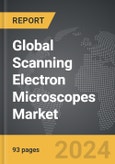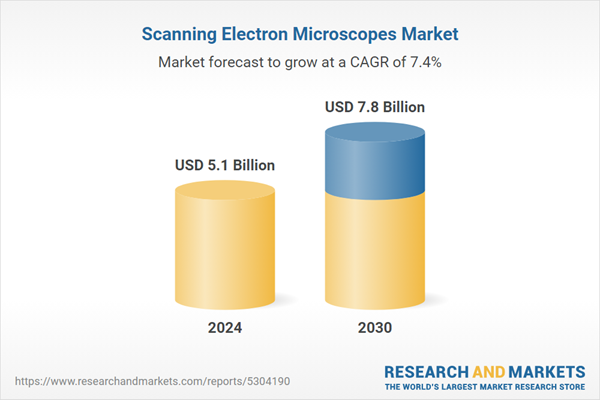The global market for Scanning Electron Microscopes was valued at US$5.1 Billion in 2024 and is projected to reach US$7.8 Billion by 2030, growing at a CAGR of 7.4% from 2024 to 2030. This comprehensive report provides an in-depth analysis of market trends, drivers, and forecasts, helping you make informed business decisions. The report includes the most recent global tariff developments and how they impact the Scanning Electron Microscopes market.
Segments: Application (Life Science, Material Science, Semiconductors, Nanotechnology, Other Applications).
Geographic Regions/Countries: World; United States; Canada; Japan; China; Europe (France; Germany; Italy; United Kingdom; and Rest of Europe); Asia-Pacific; Rest of World.
The analysts continuously track trade developments worldwide, drawing insights from leading global economists and over 200 industry and policy institutions, including think tanks, trade organizations, and national economic advisory bodies. This intelligence is integrated into forecasting models to provide timely, data-driven analysis of emerging risks and opportunities.
Global Scanning Electron Microscopes Market - Key Trends and Drivers Summarized
How Are Scanning Electron Microscopes Transforming Scientific Research?
Scanning Electron Microscopes (SEMs) are powerful imaging tools that enable researchers to examine samples at nanoscale resolution. SEMs use focused beams of electrons to produce high-resolution images of sample surfaces, making them invaluable in fields like materials science, biology, and nanotechnology. These microscopes provide detailed insights into the structure, composition, and morphology of materials, which is essential for applications ranging from drug development to semiconductor manufacturing. With advancements in SEM technology, researchers can now analyze samples with greater accuracy and efficiency, making SEMs indispensable in laboratories worldwide.What Are the Key Segments in the Scanning Electron Microscope Market?
Types of SEMs include tabletop and conventional SEMs, with conventional SEMs holding a larger market share due to their higher resolution and advanced features. Tabletop SEMs, however, are gaining popularity for their compact size and user-friendliness, making them suitable for educational and smaller research labs. Applications for SEMs include material science, life sciences, semiconductors, and forensics, with material science being the largest application due to the need for detailed analysis of microstructures and surface properties. End-users include research institutes, industrial laboratories, and academic institutions. Research institutes utilize SEMs for innovative applications in nanotechnology and biotechnology. Industrial laboratories, particularly in the semiconductor and automotive sectors, use SEMs to enhance product quality and inspect materials for defects. Academic institutions also adopt SEMs for teaching and research purposes, giving students hands-on experience with high-resolution imaging.How Are SEMs Applied Across Scientific Fields?
In materials science, SEMs are essential for examining the microstructure of metals, ceramics, and polymers, enabling scientists to improve material properties for industrial applications. In life sciences, SEMs are used to visualize cellular structures and pathogens, aiding in drug development and disease research. Semiconductor manufacturers rely on SEMs for quality control and failure analysis, as SEMs reveal defects that may affect electronic performance. Forensic labs use SEMs to analyze trace evidence, such as fibers or gunshot residue, providing valuable insights in criminal investigations.What Factors Are Driving the Growth in the Scanning Electron Microscope Market?
The growth in the Scanning Electron Microscope market is driven by several factors, including technological advancements, increased research in nanotechnology, and a growing demand for high-resolution imaging. Innovations such as energy-dispersive X-ray spectroscopy and automated imaging have expanded the capabilities of SEMs, enabling more detailed analysis. The focus on enhancing material characterization, supporting research in life sciences, and improving quality control in manufacturing has further fueled demand, as SEMs provide essential insights for these fields. Additionally, growth in academic research, increased funding for scientific research, and advancements in electron microscopy have contributed to market expansion, supporting broader adoption of SEMs.Report Scope
The report analyzes the Scanning Electron Microscopes market, presented in terms of units. The analysis covers the key segments and geographic regions outlined below.Segments: Application (Life Science, Material Science, Semiconductors, Nanotechnology, Other Applications).
Geographic Regions/Countries: World; United States; Canada; Japan; China; Europe (France; Germany; Italy; United Kingdom; and Rest of Europe); Asia-Pacific; Rest of World.
Key Insights:
- Market Growth: Understand the significant growth trajectory of the Life Science segment, which is expected to reach US$2.5 Billion by 2030 with a CAGR of a 8.5%. The Material Science segment is also set to grow at 7.7% CAGR over the analysis period.
- Regional Analysis: Gain insights into the U.S. market, valued at $1.4 Billion in 2024, and China, forecasted to grow at an impressive 7.1% CAGR to reach $1.2 Billion by 2030. Discover growth trends in other key regions, including Japan, Canada, Germany, and the Asia-Pacific.
Why You Should Buy This Report:
- Detailed Market Analysis: Access a thorough analysis of the Global Scanning Electron Microscopes Market, covering all major geographic regions and market segments.
- Competitive Insights: Get an overview of the competitive landscape, including the market presence of major players across different geographies.
- Future Trends and Drivers: Understand the key trends and drivers shaping the future of the Global Scanning Electron Microscopes Market.
- Actionable Insights: Benefit from actionable insights that can help you identify new revenue opportunities and make strategic business decisions.
Key Questions Answered:
- How is the Global Scanning Electron Microscopes Market expected to evolve by 2030?
- What are the main drivers and restraints affecting the market?
- Which market segments will grow the most over the forecast period?
- How will market shares for different regions and segments change by 2030?
- Who are the leading players in the market, and what are their prospects?
Report Features:
- Comprehensive Market Data: Independent analysis of annual sales and market forecasts in US$ Million from 2024 to 2030.
- In-Depth Regional Analysis: Detailed insights into key markets, including the U.S., China, Japan, Canada, Europe, Asia-Pacific, Latin America, Middle East, and Africa.
- Company Profiles: Coverage of players such as Bruker Corporation, Carl Zeiss, Danish Micro Engineering (DME), FEI, Hitachi High-Technologies and more.
- Complimentary Updates: Receive free report updates for one year to keep you informed of the latest market developments.
Some of the 42 companies featured in this Scanning Electron Microscopes market report include:
- Bruker Corporation
- Carl Zeiss
- Danish Micro Engineering (DME)
- FEI
- Hitachi High-Technologies
- JEOL Ltd
- Leica Microsystems
- Nanoscience Instruments
- Nikon Corporation
- Olympus Corporation
- Tescan Orsay Holding
- Thermo Fisher Scientific
Tariff Impact Analysis: Key Insights for 2025
Global tariff negotiations across 180+ countries are reshaping supply chains, costs, and competitiveness. This report reflects the latest developments as of April 2025 and incorporates forward-looking insights into the market outlook.The analysts continuously track trade developments worldwide, drawing insights from leading global economists and over 200 industry and policy institutions, including think tanks, trade organizations, and national economic advisory bodies. This intelligence is integrated into forecasting models to provide timely, data-driven analysis of emerging risks and opportunities.
What’s Included in This Edition:
- Tariff-adjusted market forecasts by region and segment
- Analysis of cost and supply chain implications by sourcing and trade exposure
- Strategic insights into geographic shifts
Buyers receive a free July 2025 update with:
- Finalized tariff impacts and new trade agreement effects
- Updated projections reflecting global sourcing and cost shifts
- Expanded country-specific coverage across the industry
Table of Contents
I. METHODOLOGYII. EXECUTIVE SUMMARY2. FOCUS ON SELECT PLAYERSIII. MARKET ANALYSISIV. COMPETITION
1. MARKET OVERVIEW
3. MARKET TRENDS & DRIVERS
4. GLOBAL MARKET PERSPECTIVE
UNITED STATES
CANADA
JAPAN
CHINA
EUROPE
FRANCE
GERMANY
ITALY
UNITED KINGDOM
REST OF EUROPE
ASIA-PACIFIC
REST OF WORLD
Companies Mentioned (Partial List)
A selection of companies mentioned in this report includes, but is not limited to:
- Bruker Corporation
- Carl Zeiss
- Danish Micro Engineering (DME)
- FEI
- Hitachi High-Technologies
- JEOL Ltd
- Leica Microsystems
- Nanoscience Instruments
- Nikon Corporation
- Olympus Corporation
- Tescan Orsay Holding
- Thermo Fisher Scientific
Table Information
| Report Attribute | Details |
|---|---|
| No. of Pages | 93 |
| Published | April 2025 |
| Forecast Period | 2024 - 2030 |
| Estimated Market Value ( USD | $ 5.1 Billion |
| Forecasted Market Value ( USD | $ 7.8 Billion |
| Compound Annual Growth Rate | 7.4% |
| Regions Covered | Global |









